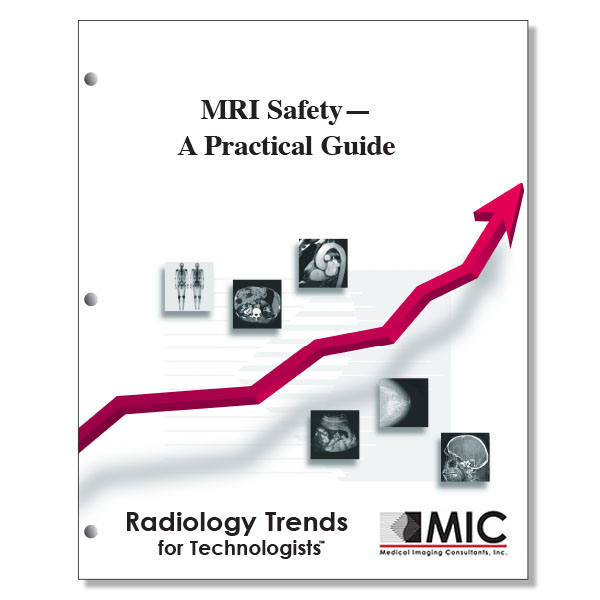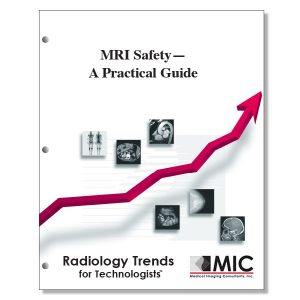

MRI Safety – A Practical Guide
An overview of MR imaging safety with practical guidance for safety issues that commonly arise.
Course ID: Q00489 Category: Radiology Trends for Technologists Modality: MRI2.75 |
Satisfaction Guarantee |
$29.00
- Targeted CE
- Outline
- Objectives
Targeted CE per ARRT’s Discipline, Category, and Subcategory classification for enrollments starting after February 14, 2023:
[Note: Discipline-specific Targeted CE credits may be less than the total Category A credits approved for this course.]
Magnetic Resonance Imaging: 2.75
Patient Care: 0.25
Patient Interactions and Management: 0.25
Safety: 2.00
MRI Screening and Safety: 2.00
Image Production: 0.50
Physical Principles of Image Formation: 0.50
Registered Radiologist Assistant: 2.25
Patient Care: 0.25
Pharmacology: 0.25
Safety: 2.00
Patient Safety, Radiation Protection, and Equipment Operation: 2.00
Radiation Therapy: 1.00
Safety: 1.00
Radiation Protection, Equipment Operation, and Quality Assurance: 1.00
Outline
- Introduction
- MR Imaging Hardware
- Main Magnet
- Gradient Systems
- Radiofrequency Coils
- Guidelines, Regulations, and Safety Terminology
- Determining Medical Device and Implant Compatibility
- MR Imaging Safety Risks
- Translational Force and Torque
- Projectile Injury
- Excessive SAR
- Burns
- Peripheral Neurostimulation
- Interactions with Active Implants and Devices
- Acoustic Injury
- MR Imaging Contrast Agents
- Pediatric MR Imaging
- MR Imaging of Unconscious or Incapacitated Patients
- MR Imaging of Pregnant Patients
- Pregnant MR Imaging Personnel
- MR Imaging Equipment Zoning and Siting
- MR Imaging Personnel and Non-MR Imaging Personnel
- MR Imaging Emergencies
- Conclusion
Objectives
Upon completion of this course, students will:
- identify the element that forms the basis for MR imaging
- list the three primary systems in an MR imaging unit
- describe the stability of the main magnetic field
- convert between the units of magnetic field strength
- list the MR imaging unit components that require cooling for proper function
- describe the energy transmission range of large radiofrequency coils
- describe the renewal cycle for ACR MR imaging institutional accreditation
- list the varying MR imaging safety criteria that are defined by the FDA
- list the MR imaging device safety labels approved by ASTM International
- describe the MR imaging device safety label of common non-ferrous intravenous catheters
- list the variables that affect the force applied on a magnetic object
- identify the time after implantation that cardiac and vascular stents are considered MR safe
- describe the technique that minimizes the field strength outside the bore of the magnet
- identify the units of measurement for SAR
- describe the relationship between increasing magnetic field strength and SAR level
- describe the characteristics of thermal injuries resulting from MR imaging
- describe the characteristics of tattoos that contribute to thermal injury during MR imaging
- describe the antenna effect and its contribution to thermal injury during MR imaging
- identify medical devices that increase the risk for thermal injury during MR imaging
- list techniques for reducing the risk for peripheral neurostimulation during MR imaging
- list techniques for reducing the risk for acoustic injury during MR imaging
- list the risk factors for reactions to GBCAs
- list the risk factors for NSF identified by the ACR Committee on Drugs and Contrast Media
- describe the estimated amount of the total dose of a GBCA expressed in breast milk
- describe the characteristics of pediatric MR imaging
- describe the performance of screening radiographs for incomplete medical histories
- describe the characteristics of MR imaging during pregnancy
- list the MR imaging job duties that can be performed by pregnant technologists
- identify the MR zone that represents the interface between uncontrolled publicly accessible areas and strictly controlled zones
- identify the MR zone that includes the MR imaging unit room and represents the highest-risk area for accidents
- list the personnel who may be considered for level 1 MR imaging personnel training
- identify the level of MR imaging personnel training required for technologists and technologist aides
- list the topics included in the training material for level 1 MR imaging personnel
- describe the device safety labels required for resuscitation and safety equipment used in the MR environment
- describe the quench procedure used to rapidly shut off the magnetic field
